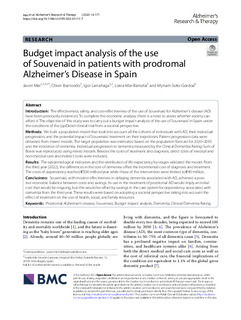| dc.rights.license | Attribution 4.0 International | * |
| dc.contributor.author | Soto-Gordoa, Myriam | |
| dc.contributor.other | Mar, Javier | |
| dc.contributor.other | Ibarrondo, Oliver | |
| dc.contributor.other | Larrañaga, Igor | |
| dc.contributor.other | Mar Barrutia, Lorea | |
| dc.date.accessioned | 2022-11-21T14:59:45Z | |
| dc.date.available | 2022-11-21T14:59:45Z | |
| dc.date.issued | 2022 | |
| dc.identifier.issn | 1758-9193 | en |
| dc.identifier.other | https://katalogoa.mondragon.edu/janium-bin/janium_login_opac.pl?find&ficha_no=170292 | en |
| dc.identifier.uri | https://hdl.handle.net/20.500.11984/5863 | |
| dc.description.abstract | Introduction
The effectiveness, safety, and cost-effectiveness of the use of Souvenaid for Alzheimer’s disease (AD) have been previously evidenced. To complete the economic analysis, there is a need to assess whether society can afford it. The objective of this study was to carry out a budget impact analysis of the use of Souvenaid in Spain under the conditions of the LipiDidiet clinical trial from a societal perspective.
Methods
We built a population model that took into account all the cohorts of individuals with AD, their individual progression, and the potential impact of Souvenaid treatment on their trajectories. Patient progression data were obtained from mixed models. The target population was estimated based on the population forecast for 2020–2035 and the incidence of dementia. Individual progression to dementia measured by the Clinical Dementia Rating-Sum of Boxes was reproduced using mixed models. Besides the costs of treatment and diagnosis, direct costs of medical and non-medical care and indirect costs were included.
Results
The epidemiological indicators and the distribution of life expectancy by stages validated the model. From the third year (2022), the differences in the cost of dementia offset the incremental cost of diagnosis and treatment. The costs of dependency reached €500 million/year while those of the intervention were limited to €40 million.
Conclusions
Souvenaid, with modest effectiveness in delaying dementia associated with AD, achieved a positive economic balance between costs and savings. Its use in the treatment of prodromal AD would imply an initial cost that would be ongoing, but this would be offset by savings in the care system for dependency associated with dementia from the third year. These results were based on adopting a societal perspective taking into account the effect of treatment on the use of health, social, and family resources. | en |
| dc.language.iso | eng | en |
| dc.publisher | Springer Nature | en |
| dc.rights | © 2022 The Authors | en |
| dc.rights.uri | http://creativecommons.org/licenses/by/4.0/ | * |
| dc.subject | Alzheimer’s disease | en |
| dc.subject | Souvenaid | en |
| dc.subject | Budget impact analysis | en |
| dc.subject | dementia | en |
| dc.subject | Clinical dementia rating | en |
| dc.title | Budget impact analysis of the use of Souvenaid in patients with prodromal Alzheimer’s Disease in Spain | en |
| dc.type | http://purl.org/coar/resource_type/c_6501 | |
| dcterms.accessRights | http://purl.org/coar/access_right/c_abf2 | en |
| dcterms.source | Alzheimer's Research & Therapy | en |
| local.contributor.group | Dirección de operaciones logístico productivas | es |
| local.description.peerreviewed | true | en |
| local.identifier.doi | https://doi.org/10.1186/s13195-022-01111-7 | en |
| local.contributor.otherinstitution | https://ror.org/01zc1f144 | es |
| local.contributor.otherinstitution | https://ror.org/028z00g40 | es |
| local.contributor.otherinstitution | Organización Sanitaria Integrada Debagoiena | es |
| local.contributor.otherinstitution | https://ror.org/01a2wsa50 | es |
| local.source.details | Vol. 14. Article 171. November, 2022 | en |
| oaire.format.mimetype | application/pdf | |
| oaire.file | $DSPACE\assetstore | |
| oaire.resourceType | http://purl.org/coar/resource_type/c_6501 | en |
| oaire.version | http://purl.org/coar/version/c_970fb48d4fbd8a85 | en |








